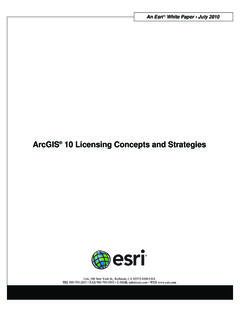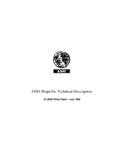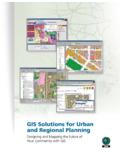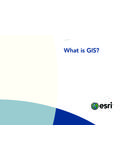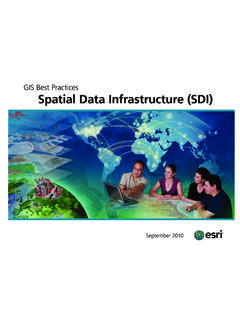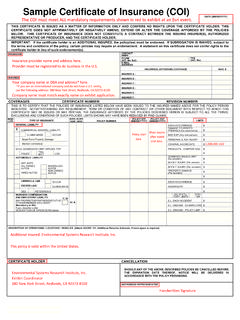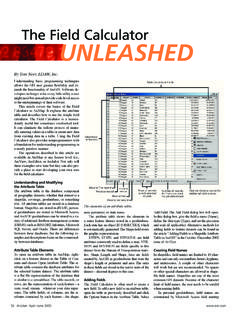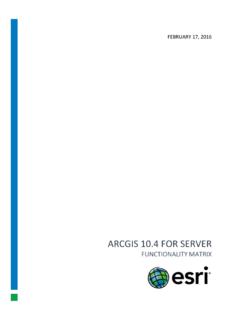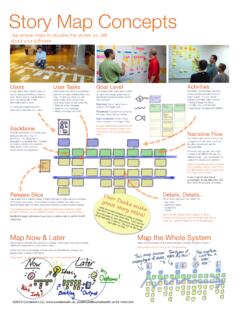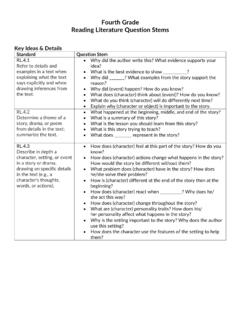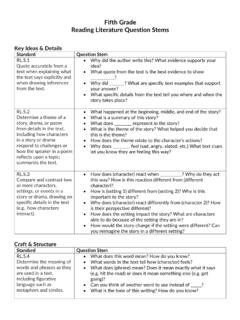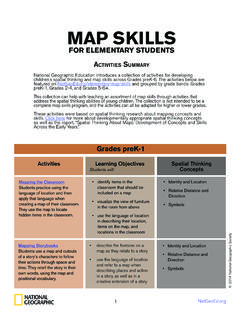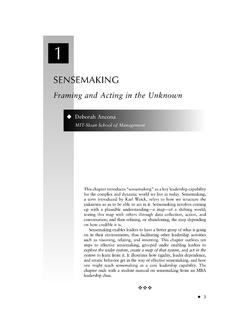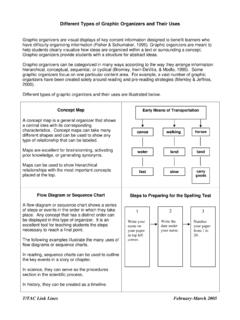Transcription of Borders, Boundaries, and Barriers - Esri
1 From the Esri GeoInquiries collection for Human GeographyTime required 15 minutesMap URL: Human geographyHUMANGEOGRAPHYB orders, boundaries, and Barriers Click the map URL above to launch the map. Zoom and pan the map to see the entire world. ?What types of boundaries are on the earth? [Boundaries can be natural, cultural, geometric, or superim-posed.] ?Why do boundaries exist? [Boundaries divide land, establish territoriality, and so on.] With the Details button underlined, click the button, Show Contents of Map (Content). Check the box to the left of the layer name, World Administrative Divisions. ?Zoom in to the continent of Europe. ?What types of boundaries can be seen? [Administrative boundaries, including province, county, and oblast.] Click a few administrative units to view the data. Hover the mouse over the layer name, World Administrative Divisions. Click the three dots and select the option, Transparency.
2 Set transparency to 50%. ?Where do you see geometric boundaries? [Northern Poland with Kaliningrad (a part of Russia)] ?Where do you see physical boundaries? [Danube River between Hungary and Slovakia] Disputed boundaries are often shown with dotted lines or notes on the map itself. ?On which boundaries do countries disagree? [United Arab Emirates and Oman, Western Sahara and Mo-rocco, Pakistan and India in Kashmir] Filter the data in the World Administrative Divisions layer. (See Tooltip on page 2.) Build the following query from the drop-down lists: Disputed Is 1. Ensure that Unique is chosen for the third drop-down list. Click Apply Filter. If results do not appear, ensure that the map is zoomed in enough that the layer name appears in dark text. ?What changed on the map? [Only places with disputes are shaded.] ?Where are most of the disputed boundaries of the world located? [Africa and Asia, and some in Europe.]
3 ] ?Why? [Instability, territorial disputes, and resource disputes.] Turn off the layer, World Administrative major boundaries, borders, and Barriers around the world. APHG: Evaluate the nature & function of boundaries including : Explain the concepts of political power and territoriality. Students will learn examples of boundaries, borders, and Barriers around the world that exhibit the organization of the earth s surface as identified through political geography. APHG BenchmarksLearning OutcomesAskAcquireExploreWhy are boundaries important?What are examples of the different types of boundaries on the earth?Are borders just boundaries?Activitymore Investigate the boundary of Western Sahara and Morocco. ?What would happen if Morocco controlled the area region? [Conflict, increased territory, and so on.] ?What natural, cultural, or political factors can affect boundaries? [Changing physical features, conflict, and territoriality.
4 ] ?How have trade and globalization affected borders and boundaries of countries around the world? [Op-portunities for interaction, trade zones, and open borders.] Click the button, Basemap. Select the basemap, Imagery with Labels. Click the button, Bookmark. Select The Great Wall of China. ?What barrier do you see? How was this boundary useful for the time when it was built? [The Great Wall of China slowed invading northern parties.] Click the Republic of Chile bookmark. ?What type of border can be found here? [The Andes Mountains create a physical boundary.] Observe the border of Chile with Peru, Bolivia, and Argentina. ?What are the advantages and disadvantages of this border? [Its length, physical features, trade opportuni-ties, and natural resources result in certain advantages and disadvantages.] Click the North and South Korea bookmark. ?What type of boundary is between these two countries?
5 [This boundary is superimposed.]AnalyzeActWhat other types of boundaries and borders exist on the earth?How can borders change?DID YOU KNOW? ArcGIS Online is a mapping platform freely available to public, private, and home schools as a part of the White House ConnectED Initiative. A school subscription provides additional security, privacy, and content features. Learn more about Arc-GIS Online and how to get a school subscription at TRY Create a story map focused on a border currently being disputed that was not discussed in this lesson. Investigate other examples of boundaries, such as the Rio Grande between the United States and Mexico, Ukraine and Russia, or another area. Next Q3 2018. Send feedback: 2015-2018 EsriBOOKMARKSFILTER Filter is only available for certain map layers. In the Details pane, press button, Show Contents of Map. Hover the mouse over layer name, click the button, Filter.
6 Set the filter parameters. Click the button, Bookmarks. Choose a bookmark name to zoom to a specified map location and REFERENCES The Human Mosaic: A Thematic Introduction to Cultural Geography by Freeman & Co. Chapter 6 An Introduction to Human Geography by Pearson Chapter 8 Human Geography: People, Place, and Culture by Wiley Press Chapter 8 This GIS map has been cross-referenced to material in sections of chapters from these texts.
